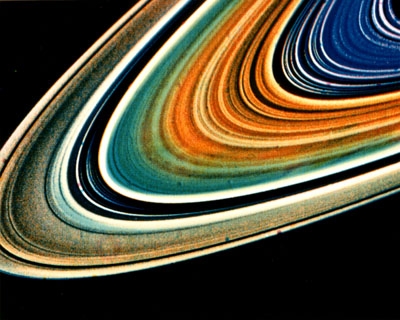August 6, 2003
Saturn
Long thought to be the only planet with a ring system, Saturn is a gas giant much like Jupiter:
- it is an enormous semi-gaseous, semi-liquid fluid sphere, crushed by its own weight and turning very rapidly on its own axis;
- it is mainly composed of hydrogen and helium;
- the surface of its thick, opaque atmosphere divides into light-coloured bands;
- it is formed around a small solid core ;
- it has an internal energy source that enables it to release 3 times more energy than it receives from the Sun.
However, smaller and less massive than Jupiter and with approximately the same density as wood, Saturn is by far the lightest planet in the solar system.

Saturn’s ring system, some 300,000 kilometres across but less than 1 kilometre thick, consists of thousands of very narrow rings of more or less densely packed solid matter. These vast quantities of solid debris, ranging from tiny dust particles to huge chunks of rock and ice spanning several hundred metres, constantly float above the planet’s equator.
While most of Saturn’s 30 natural satellites are frozen and pitted with craters, Titan stands out as the only satellite in our solar system with a dense atmosphere and organic matter. Scientists see it as a sort of frozen, primitive Earth that may help us understand how life emerged on our planet.
|
Last updated: May 2003
More about...
Mercury,
Venus,
Earth,
Mars,
Jupiter,
Uranus,
Neptune,
Pluto
How interplanetary trajectories work
CASSINI-HUYGENS, rendezvous with Saturn
How interplanetary trajectories work
CASSINI-HUYGENS, rendezvous with Saturn